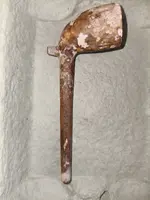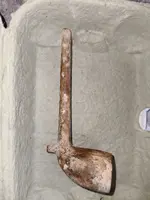Seventeenth to Early Eighteenth Century Stems Pipes at this period generally had medium length straight stems (never curved) that were quite thick at the bowl junction. As a result, fragments usually show a clear taper along their length and can be quite chunky if the fragment comes from near the bowl. Stem bores were generally large at this period and so normally range from about 9/65” to 7/64”, with a few pieces of 6/64”. Some pipes were burnished during this period and many areas of the Midlands and northern England exploited local clays, where these were available. A fine sandy fabric was used in the Oxford area and pipes from areas with access to the Coal Measures often employed clays with opaque white gritty inclusions in them. Stems of this period are usually plain and unmarked although occasionally pieces with bands of milled decoration or alternate pinching to create a ‘barley twist’ effect are found. Stem stamps are only rarely found.
 |
Seventeenth and early eighteenth-century stems showing bands of milling (1) and 'barley twist' decoration (2 and 3). Photo D. A. Higgins. |
Pipes during this period normally had quite long stems but were thinner at the bowl junction than previously. As a result, they are generally rather cylindrical in appearance with less evidence of any stem taper. Stem bores are sometimes as large as 7/64” but more typically in the 6/64” to 5/64” range. Burnishing was still used in some areas, but very rarely in the far south west, the south east and East Anglia. Local clays with inclusions were rarely used after about 1710. Stems were straight until the late eighteenth century when curved varieties were introduced. Milled bands of decoration were still occasionally used at the start of this period but maker’s stamps become more common. Initials or full name marks placed across the top of the stem were most frequently employed in central southern England and the West Midlands, while decorative stem borders were most often employed in the Midlands and north. Long line name and place stamps orientated along the top of the stem were used in the North West region during the late eighteenth century.
Late Eighteenth Century and Later Stems Pipes of this period were all made from fine clays without any obvious inclusions and they typically had stem bores of 5/64” to 4/64”. The stems were normally thinner than previously and varied in length, with nipple type mouthpieces being used on some types after about 1850. Long stems were sometimes rather oval in cross section and could be curved. Burnishing was rarely used, although it continued to be a characteristic of pipes from the Shropshire industry and on some high quality pieces from elsewhere. Stamped marks, now typically orientated along the stem, continued to be used in the West Midlands and North West but died out in other areas in favour of moulded marks. Moulded marks or pattern numbers on the sides of the stem were introduced around the middle of the nineteenth century and became the most widespread and common form of marking thereafter.
 |
Nineteenth-century moulded pattern number on the side of a stem reading No128. Photo D. A. Higgins. |







